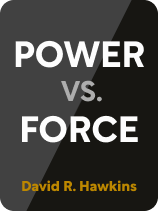

This article is an excerpt from the Shortform book guide to "Power vs. Force" by David R. Hawkins. Shortform has the world's best summaries and analyses of books you should be reading.
Like this article? Sign up for a free trial here.
How do you know whether something is true or not? Whether it’s good or bad? What does your level of consciousness have to do with it?
Despite its title, Power vs. Force by David Hawkins is really about human consciousness. Hawkins discusses his theories for what consciousness is, how to measure it, how you can boost your consciousness, and what a higher consciousness can do for you.
Continue reading for an overview of this book that could open you up to a new perspective.
Power vs. Force by David Hawkins
Our overview of Power vs. Force by David Hawkins will answer the foundational questions of what consciousness is, how to measure it, and the connection between your consciousness and your body. Then, we’ll explore Hawkins’s theories about the link between your level of consciousness and your beliefs, behaviors, and emotions, and why higher levels of consciousness create positive outcomes for both you and the world. Finally, we’ll show how Hawkins’s ideas create a virtuous cycle; in other words, why increasing your consciousness level will make it easier for you to continue increasing your consciousness level.
Hawkins (1927-2012) was a psychiatrist who specialized in treating schizophrenia and addiction. He founded or co-founded numerous organizations for psychiatric care, and he received many awards and citations for his contributions to medicine. Despite his prolific medical career, Hawkins is best known for his work in philosophy and spirituality. He spoke at many conferences and appeared on talk radio shows—including Oprah Radio—to discuss his research into the nature of human consciousness, as well as holistic health practices that encompass physical, mental, and spiritual wellness.
What Is Consciousness?
Hawkins defines “consciousness” as the ability to experience and understand yourself and your environment. Hawkins says this is possible because your brain is like a biological computer: It takes in data through your senses, then processes that data with electrical and chemical signals, resulting in what you perceive as thoughts and experiences.
Hawkins also says that your mind has access to a universal consciousness shared by all people—the universe’s internet, to extend the computer metaphor. The idea of a communal pool of human knowledge is not a new one. Psychoanalyst Carl Jung called it the “collective unconscious”: a collection of facts and beliefs that all humans share, seemingly without ever learning them. Religions have called it God, and they seek to access its knowledge either by understanding God’s will (a common theme in Christianity, for example) or by uniting with God directly (as in Hinduism).
Whatever term you prefer, Hawkins says your connection to the universal consciousness allows you to instantly know whether something is true or false, so long as you can receive and understand the universal consciousness’s signals. In other words, it’s the ultimate source of truth, and with a strong enough connection to it, you become effectively omniscient.
Measuring Human Consciousness
Since consciousness means both “awareness” and “understanding,” it logically follows that consciousness exists on a spectrum from no consciousness (having no awareness or understanding) to omniscience: total awareness and perfect knowledge of everything.
Hawkins developed a scale—what he calls the consciousness map—that measures the strength of your connection to the universal source of truth. According to Hawkins, the numbers indicate the energetic frequency of your consciousness (in other words, your consciousness level), with higher frequencies indicating more awareness and understanding than lower ones.
The Consciousness Scale
The consciousness scale includes information about key beliefs, emotions, and actions that define the various levels of consciousness. The lowest rating on the consciousness scale is level 20 to 30, which Hawkins labels as shame. Someone at this consciousness level feels that God is hateful, is constantly embarrassed about themselves and their life, and might even experience suicidal thoughts.
Higher levels of consciousness, particularly those above 300 on Hawkins’s scale, are defined by positive emotions such as compassion, calmness, and happiness. People at this level think of God as kind and caring, and they view their lives as enjoyable and fulfilling.
We’ll explore this consciousness scale and its implications in greater detail in the next section. For now, Hawkins’s crucial point is that you need a consciousness level of at least 200 (what we’ll call “bravery”) to interpret the universe’s signals. Bravery is the point at which you’re able to admit when you’re wrong and learn new things; without bravery, you’ll block out the universe’s signals if they contradict what you already believe.
Calibrating Truth With Kinesiology
Once your awareness—in other words, your consciousness—reaches a high enough level to connect to the universal consciousness, Hawkins explains that you can instantly tell whether something is true or false by using simple, scientifically proven tests. The same tests will also indicate whether something is good or bad for you.
Hawkins spent decades studying kinesiology, which is the science of how the human body moves. Through his studies, he found that the body and mind are intrinsically linked. Therefore, if your mental connection to the universal consciousness is strong enough (meaning 200 or higher), you can use basic physical tests to interpret the truth signals you’re receiving. Hawkins calls this applied kinesiology.
Hawkins describes several different kinesiology tests, but the common theme is that your muscles become weaker when you’re exposed to something that’s untrue, unhealthy, or undesirable. Crucially, this isn’t testing whether you think the statement is true; it tests whether the statement is objectively true, which is possible because of your connection to the universal consciousness. The same holds true for testing whether something is good or bad for you.
Energy and Coercion
Now, we’ll look more closely at why he believed low levels of consciousness are harmful to you and to the world—and, conversely, why high levels of consciousness lead to happiness for you and those around you. We’ll also explain why Hawkins titled this book Power vs. Force, and we’ll describe the key differences between those two things.
The Critical Point of 200
Hawkins says that 200 (bravery) is the point on the scale where you contribute at least as much as you take from society. The higher on the scale you go, the more of a net positive you become for the world. At higher levels of consciousness, you understand that the purpose of society is to help everyone live the best life possible and that contributing your resources and abilities to the common good will also improve your life.
People below 200 on the consciousness scale don’t understand this. They’re self-absorbed, so they take whatever they can from others without reciprocating.
The Coercion Scale
The lower end of the consciousness scale (below 200) represents what Hawkins calls force: aggressive, harmful, and egotistical states of consciousness. We’ll refer to this as coercion to emphasize that these states are undesirable and hurtful. When you rely on coercion, you try to get what you want by bullying or manipulating others—in other words, you work against people rather than cooperating with them. If you usually resort to coercion, you probably view life as a competition or a battle; you think in terms of “winners” and “losers” and believe that you can only get what you want by taking it from someone else.
Hawkins says that coercion might lead to short-term satisfaction, but never to true happiness. At this low level of consciousness, you’re unreceptive to the truth—you can’t determine what you really want out of life or how to get it. Hawkins does acknowledge that coercion is sometimes necessary. However, coercion should be used sparingly.
The Energy Scale
A level of 200 and above on the consciousness scale is associated with what Hawkins calls power: cooperative, loving, and understanding states of consciousness. For clarity, we’ll refer to this state as energy, to signify that it’s productive in and of itself—as opposed to coercion, which is only useful when used against something else.
Hawkins says that you reach this level of consciousness when your actions, goals, and morals are all aligned with one another. In other words, everything you do gets you closer to one of your goals; and those goals are based on your values, meaning that reaching them will make you happier.
When you’re in an energetic state of over 200 on the consciousness scale, you work together with others to achieve the best possible outcomes for both yourself and everyone else. First, you’re receptive to the universe’s truth signals, meaning that you can understand how to live a life that will make you truly happy. Second, you give more than you take—in other words, you improve the world around you.
Enlightenment: The Highest Form of Consciousness
The energy scale starts at bravery, the transitional state between coercion and energy that we previously discussed. However, according to Hawkins, bravery only has a consciousness level of 200—the highest state of consciousness is enlightenment, which begins at a consciousness level of 700 and ends at 1,000 (the highest possible rating).
When you reach enlightenment, you become part of the universal consciousness and no longer think of yourself as an individual. Thus, there’s no definable emotion or action associated with this level; you simply exist in a state of perfect understanding and serenity. In other words, it wouldn’t be accurate to say that you’re happy after reaching enlightenment. Instead, you’re completely at peace, free of even the desire for happiness.
Summing It Up: The Virtuous Cycle
Throughout Power vs. Force, Hawkins emphasizes that improving your consciousness will drive you to keep improving. He’s arguably describing a virtuous cycle: a repetitive process where each step feeds constantly into the next, leading to better and better outcomes. (You could also call this a positive feedback loop.)
The virtuous cycle that Hawkins describes has four steps: develop cooperative energy, reduce your reliance on aggressive coercion, elevate your level of consciousness, and increase your receptiveness to truth. Each step leads to the next, with the final step (increase receptiveness to truth) leading back to the first (develop cooperative energy). These four steps together produce two outcomes: become happier and make the world better.

———End of Preview———
Like what you just read? Read the rest of the world's best book summary and analysis of David R. Hawkins's "Power vs. Force" at Shortform.
Here's what you'll find in our full Power vs. Force summary:
- A complete guide to human consciousness
- How to connect with universal consciousness and glean its insights
- How to use applied kinesiology to tell if something is true or false






